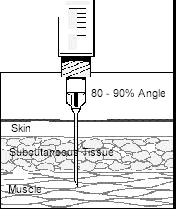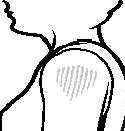Diabetes
Diabetes is a life-long disease marked by elevated levels of sugar in the blood. It can be caused by too little insulin (a chemical produced by the pancreas to regulate blood sugar), resistance to insulin, or both.
Types
- Type 1 diabetes is usually diagnosed in childhood. The body makes little or no insulin, and daily injections of insulin are required to sustain life.
- Type 2 diabetes is far more common than type 1 and makes up about 85% of all cases of diabetes. It usually occurs in adulthood. Here, the pancreas does not make enough insulin to keep blood glucose levels normal, often because the body does not respond well to the insulin. Many people with type 2 diabetes do not know they have it, although it is a serious condition. Type 2 diabetes is becoming more common due to the growing number of older people, increasing obesity levels, and widespread failure to exercise.
Insulin
When glucose levels rise as a result of glycogen conversion or intake of food from a meal, a hormone, released from Beta cells, called insulin, is secreted into the bloodstream. Insulin's effect on the liver causes it to convert excess glucose into glycogen, also muscle and connective tissue cells are stimulated to take on, and use more glucose thus reducing levels in the blood . People with type I diabetes can't make their own insulin, and they must take insulin every day.
Diabetes UK give a very good explanation how insulin works "Insulin is the key that unlocks the door to the body’s cells. Once the door is unlocked glucose can enter the cells where it is used as fuel. In Type 1 diabetes the body is unable to produce any insulin so there is no key to unlock the door and the glucose builds up in the blood." (http://www.diabetes.org.uk)
Symptoms
Type 1:
- Increased thirst
- Increased urination
- Weight loss in spite of increased appetite
- Fatigue
- Nausea
- Vomiting
Type 2:
- Increased thirst
- Increased urination
- Increased appetite
- Fatigue
- Blurred vision
Complications
Over time, diabetes can lead to:
- Heart and blood vessel disease - Hardening of the arteries (atherosclerosis).
- Blindness - Damage to blood vessels that feed the retina of the eye
- Kidney damage/failure - High blood sugar levels cause damage. these patients must then have dialysis treatment or a kidney transplant
- Foot Ulcers - Due to poor circulation to the extremities. Nerve damage also occurs
Diabetic Emergencies
Hypoglycaemia
Hypoglycaemia or low blood glucose is a condition in which the level of glucose (sugar) in the blood, drops below a certain point (about 2.5mmol/l). The condition manifests itself by a number of symptoms that usually disappear 10 to 15 minutes after eating sugar. People differ slightly in the exact level of blood glucose at which they begin to feel symptoms of low blood sugar.
The following can bring on a "Hypo":
- Excess exercise
- Decreased food intake
- Overdose of insulin
- Overdose of oral hypoglycaemic agents
- Alcohol overdose
Signs of a Patient Having a Hypo:
Cold, clammy or sweaty skin
Pallor
Difficulty concentrating
Shakiness, lack of coordination
Irritability, hostility, and poor behaviour
A staggering gait
Fatigue
Headache
Blurred vision and dizziness
Abdominal pain or nausea
Fainting and unconsciousness
Glucagon
Glucagon stimulates breakdown of glycogen stored in the liver. When blood glucose levels are high, large amounts of glucose are taken up by the liver. Under the influence of insulin, much of this glucose is stored in the form of glycogen. Later, when blood glucose levels begin to fall, glucagon is secreted and acts on hepatocytes to activate the enzymes that depolymerise glycogen and release glucose.
Glucagon is a hormone produced in the pancreas. Glucagon is used to raise very low blood sugar.
Glucagon has a major role in maintaining normal concentrations of glucose in blood, and is often described as having the opposite effect of insulin. That is, glucagon has the effect of increasing blood glucose levels.
Glucagon is usually given by injection beneath the skin, in the muscle. It comes as a powder and liquid that will need to be mixed just before administering the dose. Glucagon should be administered as soon as possible after discovering that the patient is unconscious from low blood sugar. After the injection, the patient should be turned onto the side to prevent choking if they vomit. When the patient comes round you'll need to encourage them to eat carbohydrates as they will be suffering a glucose deficiency.
Intramuscular Injection

Below are instructions on how to carry out this procedure:
- Use a needle long enough to reach deep into the muscle.
- Insert needle at an 80º to 90º angle to the skin with a quick thrust
- Retain pressure on skin around injection site with thumb and index finger while needle is inserted.
- After inserting needle pull back on the plunger slightly, if blood appears after negative pressure, the needle should be withdrawn and a new site selected.
- If no blood is visible carry on inserting medication.
Glucagon
Click here for drug information
Hypostop
Hypostop is a tube of concentrated glucose gel that can be given to someone who has known or suspected Hypoglycaemia in a conscious patient without any risk of choking or aspiration.
Click here for drug information
Hyperglycaemia
Hyperglycaemia means a high blood glucose level and usually refers to a glucose level above 15 mmol/L. In the short term if untreated it may lead to feelings of being unwell and infections.
In the long term it may lead to damage in parts of the body. There are several reasons for developing high blood glucose levels.
Stress may be one of the causes for the increase. Medical causes may be chest infections, common illnesses and some medications.
High blood glucose levels may occur when a person does not take enough of their diabetes medication, poorly educated in their condition or no insulin is taken at all. It has been reported that, especially young adults, have been known to consistently run with high blood glucose to assist with weight loss as the body starts to burn its fat reserves to get energy.
Management of Diabetic Emergencies
Carry out a blood sugar test, Administer IM Glucagon or Hypostop in the case of hypoglycaemia, Administer high concentration of O2, Give patient carbohydrates when their level of consciousness increases sufficiently reducing a possible choking hazard, Continually monitor blood sugar levels until it raises to 4 mmol/L. If a patient does not respond to your treatment then consider moving to hospital or calling for paramedic assistance. Usually once low blood glucose has been resolved then the patient can be left at home with worsening care advice.Consider an ASHICE
Continue monitoring vital signs
Smooth and rapid journey to hospital
Professional handover to hospital staff
